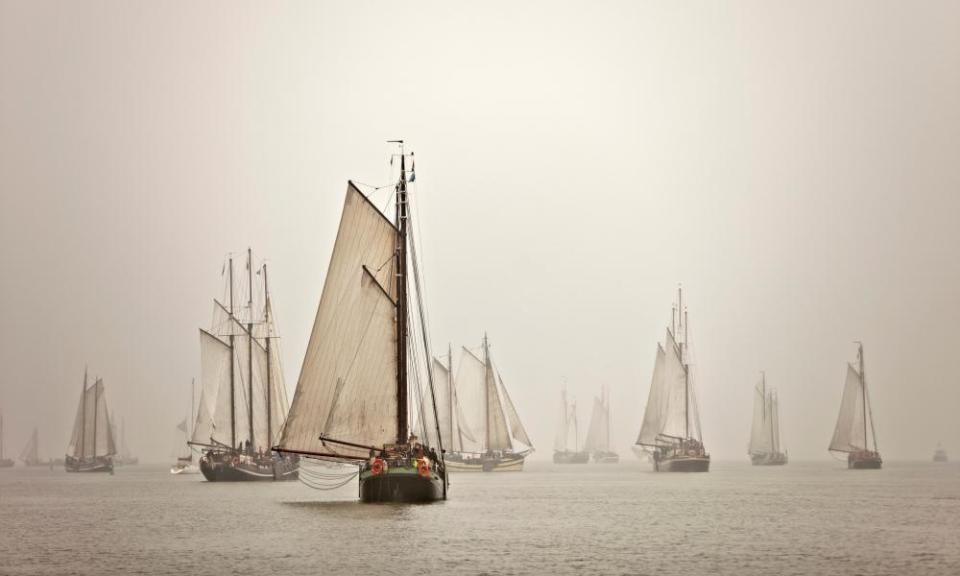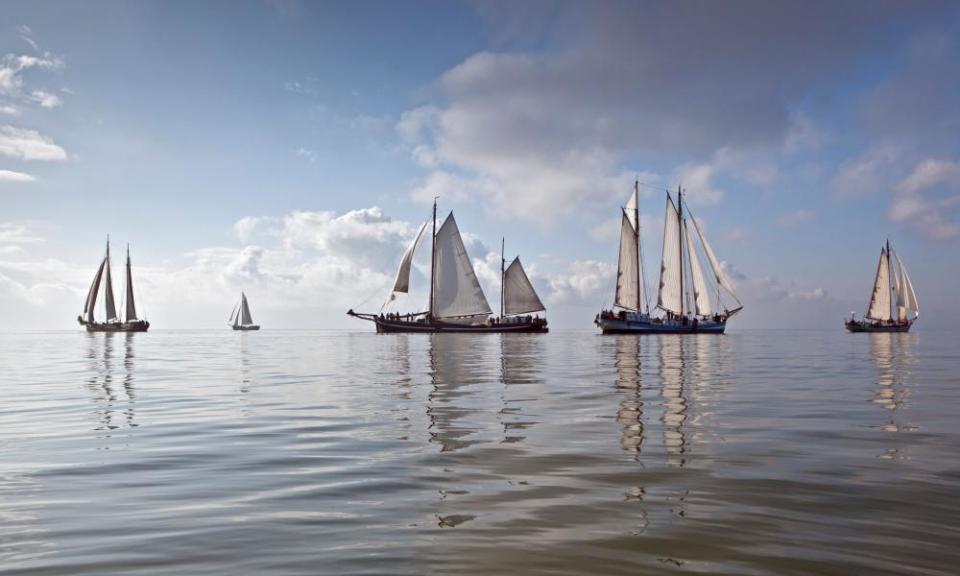Sinking Dutchman: world’s largest historical sailing fleet threatened by Covid-19

If it weren’t for Covid-19, Sven Timmann would be sailing the relatively calm inland waters of the Netherlands with groups of schoolchildren, businesspeople and families. Instead, his ship, the Ambiance – a 112-year-old clipper with three masts and six sails – has been docked since October, and there is a good chance it will never sail again.
A sturdy, bearded man with an anchor tattoo who bought the 39-metre Ambiance after moving to the Netherlands from Germany to attend nautical college, Timmann has already seen a 90% loss of revenue this season. He expects to be bankrupt by the end of the year. “The ship has sailed through wars and storms,” he says. “How can it be that a tiny virus now threatens the entire fleet?”
The Netherlands is home to the world’s largest historical sailing fleet. Traditionally used to transport goods, these century-old vessels are like something out of Pirates of the Caribbean, with sailors hanging from the rigging and climbing the mast to the crow’s nest to unfurl the sails. They are also a way of life: since 2007 Timmann has lived on his black ship, among the memories of countless hours of watchkeeping, navigating by the stars and hauling on ropes with blistered fingers.
In other countries, vessels such as these are museum pieces, sailing only on special occasions. In the Netherlands, however, they are working ships, linking past and present as a vital part of the maritime economy and giving students a hands-on lesson about their country’s history. Most of these sailing trips last a week long, while a small number of ships run day trips.
The ship has sailed through wars and storms. How can it be that a tiny virus now threatens the entire fleet?
Sven Timmann, skipper
But coronavirus threatens to scupper the majority of the 400 vessels in the Netherlands. Because of pandemic-control measures, the ships cannot sail and no tourists may board. Sailing requires close teamwork that is simply impossible under the government-mandated distancing rules.
“We need five people pulling on one rope to hoist a sail,” Timmann says. “This cannot be done alone.” In the cabins below deck, it is also impossible to keep distance.
All planned trips – Timmann charges up to €300 (£279) a person per day, though much less for students – have been cancelled, and he must refund the money.
On 10 July, the government eased the rule requiring 1.5m distancing, but it applies only to day trips, which account for only 10% of sailing trips, says Paul van Ommen, director of the ship owner association BBZ. “This is nowhere near enough to save the fleet,” he says. For Timmann nothing has changed: “I run overnight trips, that is how my ship and business are built.” Having already lost 4 months of income, the overnight trips are even more important now.
Certificates for historical vessels must also be renewed every five years, at a cost of thousands of euros. If a certificate expires, the ship must be rebuilt to modern standards – a prohibitive investment for the owners.
Related: Scottish fishermen turn to food banks as Covid-19 devastates industry
What’s more, historical ships require constant maintenance. According to BBZ, the fleet needs €20m just to stay afloat into the new year.
“A day of sailing means two days of upkeep,” says Van Ommen. Half of a skipper’s annual income goes on maintenance. A damaged sail costs €5,000 to €8,000, and paint €3,000 a season. The longer the ships are idle, the more their value slides for lack of repairs and rust.
Timmann worries that creditors could eventually seize his ship. His worst nightmare is that he could be forced to demolish the vessel.
“The Ambiance, like many other ships in the Dutch fleet, is over 100 years old. It would be terrible if this craftmanship is destroyed,” he says. Industries such as rope production and shipbuilding could never recover.
The government has provided some aid, but skippers say it falls short of what is needed. Each sailing company – often one-person businesses – received €4,000 in April. Timmann’s usual annual revenue is €165,000. A second aid package is in the works for the recreation industry, but with handouts based on the size of companies, skippers fear their operations are too small to receive anywhere near what they need.

The Dutch economic affairs secretary, Mona Keijzer, who recently visited the sailors in the Dutch harbour of Kampen on the banks of the IJssel River, says she knows aid has fallen short. “It hurts to see these entrepreneurs lose their businesses, but we need to also remember that the financial aid comes from the taxpayer and must be spent with diligence,” says Keijzer.
Other industries can be rebuilt or restarted. But the Dutch ships, the sailing heritage, is irreplaceable
Paul van Ommen, BBZ
Government debate over additional aid will not begin until August. That will be too late for some ships.
“The first ship has already gone bankrupt, and several others are down to the last €2,000 in their bank accounts,” says Van Ommen. If creditors seize the vessels and can’t find buyers, Timmann says, “demolishing the ships is the cheapest option”.
“Other industries can be rebuilt or restarted. But the Dutch ships, the sailing heritage, is irreplaceable,” says Van Ommen.
For those like Timmann who are still living that heritage today, the blow would be personal.
“This is our life,” says Timmann. “If I had to quit sailing, I wouldn’t know what else to do.”
Watch the latest videos from Yahoo UK

 Yahoo Finance
Yahoo Finance 